A Novel Multistep Mechanism for Oxygen Binding to Ferrous Hemoproteins:
advertisement
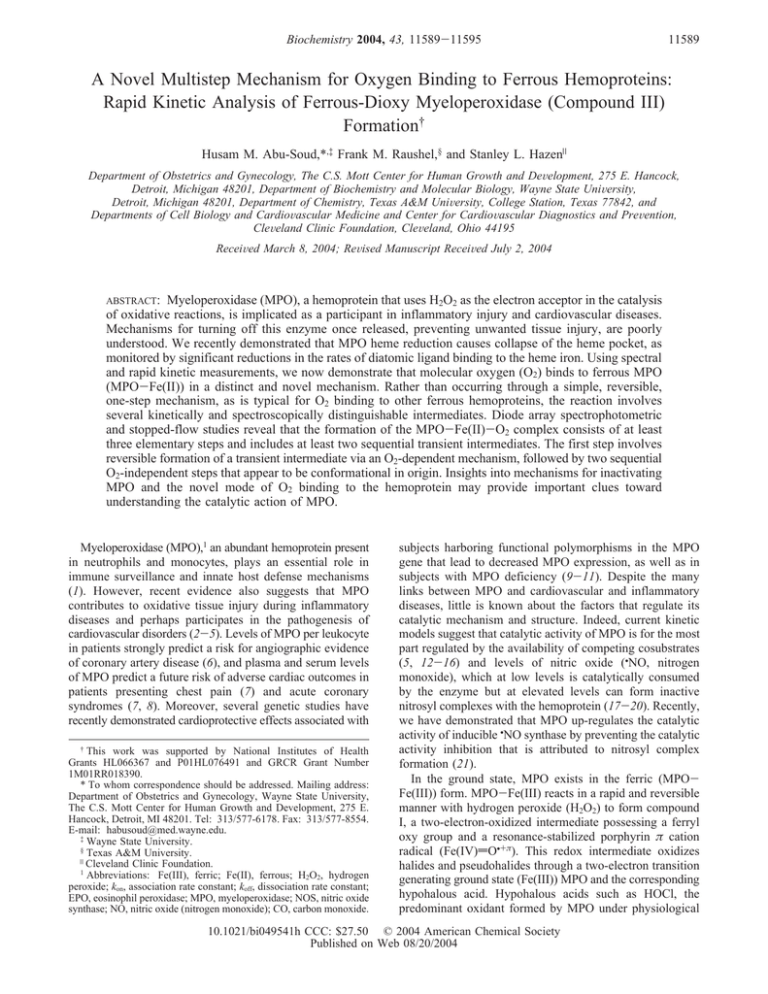
Biochemistry 2004, 43, 11589-11595 11589 A Novel Multistep Mechanism for Oxygen Binding to Ferrous Hemoproteins: Rapid Kinetic Analysis of Ferrous-Dioxy Myeloperoxidase (Compound III) Formation† Husam M. Abu-Soud,*,‡ Frank M. Raushel,§ and Stanley L. Hazen| Department of Obstetrics and Gynecology, The C.S. Mott Center for Human Growth and DeVelopment, 275 E. Hancock, Detroit, Michigan 48201, Department of Biochemistry and Molecular Biology, Wayne State UniVersity, Detroit, Michigan 48201, Department of Chemistry, Texas A&M UniVersity, College Station, Texas 77842, and Departments of Cell Biology and CardioVascular Medicine and Center for CardioVascular Diagnostics and PreVention, CleVeland Clinic Foundation, CleVeland, Ohio 44195 ReceiVed March 8, 2004; ReVised Manuscript ReceiVed July 2, 2004 ABSTRACT: Myeloperoxidase (MPO), a hemoprotein that uses H2O2 as the electron acceptor in the catalysis of oxidative reactions, is implicated as a participant in inflammatory injury and cardiovascular diseases. Mechanisms for turning off this enzyme once released, preventing unwanted tissue injury, are poorly understood. We recently demonstrated that MPO heme reduction causes collapse of the heme pocket, as monitored by significant reductions in the rates of diatomic ligand binding to the heme iron. Using spectral and rapid kinetic measurements, we now demonstrate that molecular oxygen (O2) binds to ferrous MPO (MPO-Fe(II)) in a distinct and novel mechanism. Rather than occurring through a simple, reversible, one-step mechanism, as is typical for O2 binding to other ferrous hemoproteins, the reaction involves several kinetically and spectroscopically distinguishable intermediates. Diode array spectrophotometric and stopped-flow studies reveal that the formation of the MPO-Fe(II)-O2 complex consists of at least three elementary steps and includes at least two sequential transient intermediates. The first step involves reversible formation of a transient intermediate via an O2-dependent mechanism, followed by two sequential O2-independent steps that appear to be conformational in origin. Insights into mechanisms for inactivating MPO and the novel mode of O2 binding to the hemoprotein may provide important clues toward understanding the catalytic action of MPO. Myeloperoxidase (MPO),1 an abundant hemoprotein present in neutrophils and monocytes, plays an essential role in immune surveillance and innate host defense mechanisms (1). However, recent evidence also suggests that MPO contributes to oxidative tissue injury during inflammatory diseases and perhaps participates in the pathogenesis of cardiovascular disorders (2-5). Levels of MPO per leukocyte in patients strongly predict a risk for angiographic evidence of coronary artery disease (6), and plasma and serum levels of MPO predict a future risk of adverse cardiac outcomes in patients presenting chest pain (7) and acute coronary syndromes (7, 8). Moreover, several genetic studies have recently demonstrated cardioprotective effects associated with † This work was supported by National Institutes of Health Grants HL066367 and P01HL076491 and GRCR Grant Number 1M01RR018390. * To whom correspondence should be addressed. Mailing address: Department of Obstetrics and Gynecology, Wayne State University, The C.S. Mott Center for Human Growth and Development, 275 E. Hancock, Detroit, MI 48201. Tel: 313/577-6178. Fax: 313/577-8554. E-mail: habusoud@med.wayne.edu. ‡ Wayne State University. § Texas A&M University. | Cleveland Clinic Foundation. 1 Abbreviations: Fe(III), ferric; Fe(II), ferrous; H2O2, hydrogen peroxide; kon, association rate constant; koff, dissociation rate constant; EPO, eosinophil peroxidase; MPO, myeloperoxidase; NOS, nitric oxide synthase; NO, nitric oxide (nitrogen monoxide); CO, carbon monoxide. subjects harboring functional polymorphisms in the MPO gene that lead to decreased MPO expression, as well as in subjects with MPO deficiency (9-11). Despite the many links between MPO and cardiovascular and inflammatory diseases, little is known about the factors that regulate its catalytic mechanism and structure. Indeed, current kinetic models suggest that catalytic activity of MPO is for the most part regulated by the availability of competing cosubstrates (5, 12-16) and levels of nitric oxide (•NO, nitrogen monoxide), which at low levels is catalytically consumed by the enzyme but at elevated levels can form inactive nitrosyl complexes with the hemoprotein (17-20). Recently, we have demonstrated that MPO up-regulates the catalytic activity of inducible •NO synthase by preventing the catalytic activity inhibition that is attributed to nitrosyl complex formation (21). In the ground state, MPO exists in the ferric (MPOFe(III)) form. MPO-Fe(III) reacts in a rapid and reversible manner with hydrogen peroxide (H2O2) to form compound I, a two-electron-oxidized intermediate possessing a ferryl oxy group and a resonance-stabilized porphyrin π cation radical (Fe(IV)dO•+π). This redox intermediate oxidizes halides and pseudohalides through a two-electron transition generating ground state (Fe(III)) MPO and the corresponding hypohalous acid. Hypohalous acids such as HOCl, the predominant oxidant formed by MPO under physiological 10.1021/bi049541h CCC: $27.50 © 2004 American Chemical Society Published on Web 08/20/2004 11590 Biochemistry, Vol. 43, No. 36, 2004 levels of halides (22, 23), play an important role in killing microorganisms (24, 25). However, overproduction of halogenating oxidants can injure normal tissues by oxidative modification of proteins and lipoproteins, bleaching of heme groups, and oxidative destruction of electron transport chains (26, 27). Like other peroxidases, MPO compound I can also oxidize multiple organic and inorganic compounds by two successive one-electron transitions generating radical species and the peroxidase intermediates compound II (Fe(IV)dO) and ground state Fe(III) enzyme (5, 12-16). Oxidation of • NO by MPO occurs via this sequential pathway (5, 1720) and has been linked to endothelial dysfunction in cardiovascular disease and sepsis through catalytic consumption of •NO (17-20, 28). Similarly, MPO may also use nitrite (NO2-), a major end product of •NO metabolism, as a oneelectron substrate to generate nitrogen dioxide (•NO2) (29), a diffusible radical implicated in both nitration of protein tyrosyl residues in vivo (28), and LDL modification and conversion into an atherogenic form (27-32). Mechanisms for “shutting off” MPO activity are thus of considerable interest. MPO is highly resistant to protease and chemical inactivation, a property likely the result of evolutionary pressures for development of an enzyme that produces caustic reactive oxidant species within the harsh environs of the phagolysosomal compartment. Over 2 decades ago, it was recognized that heme reduction of MPO-Fe(III) converts the enzyme into an inactive ferrous MPO (MPO-Fe(II)) form (12). A variety of physiological reductants, including NADPH, ascorbate, and superoxide (O2•-), can inhibit MPO catalysis (12). It has also been suggested that O2 binding to MPO-Fe(II), and O2•- binding to MPO-Fe(III), each leads to formation of another inactive form, a ferrous dioxy intermediate termed compound III (MPO-Fe(II)-O2) (12, 33). With the use of a combination of rapid kinetic methods and diatomic ligand binding studies with NO and CO, changes in the heme pocket environment attendant with heme reduction were monitored (20). A model was developed suggesting that MPO heme reduction is accompanied by significant alterations (collapse) in the heme environment, preventing access of substrates to the catalytic site of the enzyme (20). We now show that O2 binding to MPO-Fe(II) proceeds through a complex multistep process, including generation of at least two kinetically and spectroscopically distinct transient Fe(II)-O2-like intermediates. As far as we are aware, this behavior is unique among hemoprotein model compounds and advances our understanding of the catalytic cycle of MPO. Collectively, these kinetic behaviors distinguish MPO from other hemoprotein model compounds and provide a foundation to advance our understanding of the catalytic cycle of MPO. EXPERIMENTAL PROCEDURES (MATERIALS AND METHODS) Materials. O2 gas was purchased from Matheson Gas products, Inc., and used without further purification. All other reagents and materials were of the highest purity grades available and obtained from either Sigma Chemical Co. or Aldrich. Enzyme Purification. MPO was purified from detergent extracts of human leukocytes as described (34). Trace levels Abu-Soud et al. of contaminating eosinophil peroxidase were then removed by passage over a sulfopropyl Sephadex column (35). Purity of isolated MPO was established by demonstrating a Reinheitzal (RZ) value of >0.85 (A430/A280), by SDS PAGE analysis with Coomassie Blue staining, and by in-gel tetramethylbenzidine peroxidase staining to confirm no observable contaminating eosinophil peroxidase activity. Enzyme concentration was determined spectrophotometrically utilizing a molar extinction coefficient of 89 000 M-1 cm-1/heme of MPO (36). Optical Spectroscopy and Rapid Kinetic Measurements. Optical spectra were recorded on a Cary 100 UV-visible spectrophotometer at 25 °C. Anaerobic spectra were recorded using septum-sealed quartz cuvettes that were attached through quick-fit joints to an all-glass vacuum train system. MPO samples were made anaerobic by several cycles of evacuation and equilibrated with catalyst-deoxygenated N2. Separate buffer solutions were evacuated, gassed with N2, and anaerobically transferred either to the stopped-flow instrument or to anaerobic cuvettes using gastight syringes. Cuvettes were maintained under N2 positive pressure during spectral measurements. All kinetic measurements were performed with a temperature-controlled stopped-flow apparatus (180-π*, Applied Photophysics) equipped for anaerobic work. Measurements were carried out at 10 °C and initiated by rapidly mixing equal volumes of the enzyme solutions (0.86 µM) with buffer solution supplemented with increasing concentrations of O2. The reaction for O2 binding to MPO was monitored at wavelengths determined on the basis of the spectral changes that occur upon O2 binding to MPO-Fe(II), as indicated in the text. In all cases, the MPO-Fe(III) samples were reduced by a slight molar excess of dithionite prior to mixing with O2. In a control experiment, the reduced MPO sample was applied to a PD-10 Sephadex G-25-M column (Amersham Biosciences) equilibrated with an anaerobic phosphate buffer to eliminate any dithionite residual presence that may interfere in the reaction. The column was eluted with the same buffer under anaerobic conditions, and the enzyme sample was collected, adjusted to the desired concentration, and then transferred using Hamilton gastight syringe to the stopped-flow reservoir, which is maintained under nitrogen atmosphere. The MPO-Fe(II) and O2 solutions were allowed to cool to 10 °C in syringes housed in the stopped-flow instrument (closed to the atmosphere) prior to mixing. In both cases, comparable results were observed monitoring the reaction of MPO-Fe(II) with O2 indicating that residual dithionite present in the reaction system has no influence on the kinetic results. To determine the apparent rate constants for generation of MPO-Fe(II)-O2 complex, the time course of absorbance change was fit to single (Y ) 1 - e-kt) or double (Y ) A e-kt + B e-k2t + C) exponential functions using a nonlinear least-squares method provided by the instrument manufacturer. Signal-to-noise ratios were improved by averaging 7-10 individual traces for each experiment. Solution Preparation. Anaerobic 0.2 M sodium phosphate buffer solutions, pH 7.0, containing various concentrations of O2 were prepared by mixing different volumes of buffer saturated with O2 gas at 21 °C with anaerobic buffer solution. Saturation was achieved by bubbling O2 for 1 h in a septumsealed flask at 21 °C. Final O2 concentrations were calculated Oxygen Binding to Myeloperoxidase FIGURE 1: Formation of MPO-Fe(II)-O2 complex. Diode array rapid scanning spectra for the intermediates and final product formed by reacting MPO-Fe(II) with air-saturating buffer at two sequential time frames are shown. Spectra traces were collected at 0.01, 0.05, 0.075, 0.1, 0.125, and 0.15 s (panel A) and at 0.2, 0.25, 0.3, 0.4, and 0.5 s (panel B) after mixing an anaerobic solution containing 3.6 µM MPO-Fe(II) with an equal volume of airsaturated buffer solution. Experiments were performed under anaerobic conditions in sodium phosphate buffer (200 mM, pH 7.0) at 10 °C. Arrows indicate the direction of spectral change over time as each intermediate advanced to the next. on the basis of a saturating concentration of O2 of ∼1.2 mM at 21 °C and 1 atm pressure. RESULTS Initial Rapid Spectroscopic Characterization of O2 Binding to Ferrous MPO. Addition of a slight molar excess of dithionite to MPO-Fe(III) caused immediate MPO heme iron reduction, as judged by a shift in the Soret absorbance peak from 430 to 473 nm, and the appearance of additional absorbance peaks in the visible range at 642 nm, as previously reported (12, 16, 18). To investigate more closely the formation of the MPO-Fe(II)-O2 complex, compound III, we first monitored absorbance changes versus time upon mixing prereduced MPO (i.e., MPO-Fe(II)) with O2equilibrated buffer at 10 °C, using a diode array stoppedflow instrument. The characteristics of the spectral change occurring in the various time ranges through the reaction of MPO-Fe(II) with O2 are shown in Figure 1, panels A and B. The variety of shapes of the reaction curves as a function of time indicates that the reaction involves several intermediates having different distinct spectral properties. The first set of the spectral alterations, of which the Soret spectrum was characterized by absorbance peak at 434 and additional visible peaks at 575, 627, and 700 nm (Figure 1, panel A), occurs within 0.2 s after mixing at 10 °C. These spectral changes were unstable and converted to the final form shown (Figure 1, panel B) within 6 s, as evidenced by a timedependent shift in Soret and visible absorbance peaks to 450, 577, and 627 nm through isosbestic points located at 440, 547, 597, and 640 nm. The spectral changes that occur through the reaction of MPO-Fe(II) and O2 differ from that observed with either ferric or ferrous forms of MPO, the Biochemistry, Vol. 43, No. 36, 2004 11591 FIGURE 2: Single-wavelength stopped-flow traces for the reaction of MPO-Fe(II) with air-saturated buffer monitored at 460 nm. An anaerobic solution containing 1.0 µM MPO-Fe(II) [prepared by mixing MPO-Fe(III) with a slight molar excess of dithionite] was rapidly mixed with an equal volume of sodium phosphate buffer (200 mM, pH 7.0) supplemented with differing concentrations of O2 at 10 °C. Experiments were carried out by monitoring the change in absorbance at 460 nm (where all the intermediates have been observed). The inset depicts the absorbance changes that occurred within the first 200 ms of the reaction. Soret absorbance maxima of which are centered at 430 and 473 nm, respectively (12, 16, 18). However, the final spectral changes (Figure 1, panel B) are identical to that previously reported for MPO-Fe(II)-O2 complex generated from either MPO-Fe(III) in the presence of NADH, O2, and 2,4dichlorophenol, which is known to be an activator of the aerobic oxidation of NADH by peroxidase, or from a direct reaction of MPO-Fe(II) and O2 (37, 38). Collectively, these results indicate that O2 binds MPO-Fe(II) generating one or more transient intermediates before generating a more stable, low-spin, six-coordinate Fe(II)-O2 complex, classically known as compound III. Kinetic Analysis of O2 Binding to Ferrous MPO. The time course for the appearance of MPO-Fe(II)-O2 obtained at various single wavelengths indicates that the reaction is triphasic with sequential steps occurring at sufficiently different rates to enable each process to be studied by conventional stopped-flow methods. Experiments were performed under pseudo-first-order conditions by rapid mixing of equal volumes of MPO-Fe(II) with buffer solutions supplemented with different O2 concentrations. A trace obtained at 460 nm, a wavelength selected because it permits kinetic assessment of both early and late phases of the reaction, is shown in Figure 2. An initial rapid absorbance decrease was observed, followed by a slower increase in absorbance. The inset to Figure 2 shows the change in absorbance at 460 nm that takes place during the first 0.20 s of the reaction. An initial lag phase in the curve (over the first 25 ms) was observed, indicating that a faster process not visible at this wavelength is involved. Consistent with this notion, the absorbance changes at 460 nm during the first 0.2 s of the reaction were best fitted to a doubleexponential function with observed rate constants of 65 and 23 s-1. The absorbance decrease at 460 nm was followed by a slower increase in absorbance, which was best fit to a single-exponential function with an observed pseudo-firstorder rate constant of 0.73 s-1. These results collectively support the presence of at least three sequential kinetically distinct intermediate reactions during the overall interaction between MPO-Fe(II) and O2. In addition, comparable results were observed monitoring MPO-Fe(II) reaction with O2 11592 Biochemistry, Vol. 43, No. 36, 2004 Abu-Soud et al. FIGURE 4: A kinetic model accounting for the complex mechanism of O2 binding to MPO-Fe(II), incorporated within the context of the classic peroxidase cycle. FIGURE 3: Effect of O2 concentration on the formation of various oxygenated MPO-Fe(II) intermediates. Spectral changes and kinetic measurements indicate that the reactions are triphasic. Panel A plots the observed rates for the formation of the first phase ([MPO-Fe(II)-O2]′) versus O2 concentration, while panel B plots the observed rates for the formation of the second and third phases ([MPO-Fe(II)-O2]′′ and MPO-Fe(II)-O2, respectively) versus O2 concentration. following removal of any residual dithionite by passage of the prereduced MPO sample over a desalting column. This behavior indicates that residual dithionite present in the reaction solution has no impact on the kinetic results. Because of the unusual nature of MPO-Fe(II)-O2 interactions, we further examined the kinetics of formation of the transient intermediate species as a function of O2 concentration. Pseudo-first-order rate constants of their formation were ascertained and plotted as a function of O2 concentration (Figure 3). The plot of the pseudo-first-order rate constant for the initial Fe(II)-O2 complex (kinetically modeled and detected as the lag phase in the initial reaction; Figure 2 insert) was linear with a positive intercept, indicating that formation of the first detectable intermediate is O2dependent and reversible and proceeds through a simple, onestep mechanism with kon of 7.1 × 104 M-1 s-1 and koff of 63 s-1 (Figure 3, panel A). The subsequent conversion of this intermediate into the kinetically and spectroscopically distinct second and third intermediates occurred via mechanisms independent of O2 concentration (Figure 3, panels B and C), indicating that these steps are both irreversible and likely conformational in nature. DISCUSSION For over 100 years, biochemists have studied the binding of molecular O2 to hemoproteins such as hemoglobin, both because of its importance to various biological functions and because of the ease with which it may be monitored. Upon O2 binding to the iron atom of hemoproteins, marked alterations in the spectral properties of the prosthetic group typically occur, a process known as a shift in the Soret absorbance spectrum (39-51). In all cases thus far described, O2 binding occurs through a simple, either one- or two-step process (39-51). In a one-step model (e.g., E + O2 T EO2), increasing O2 concentration results in an ever-increasing observed pseudo-first-order rate constant of binding to the heme moiety (52). In a two-step mechanism (e.g., E + O2 T E′-O2 T E′′-O2), the rate of O2 binding to the heme exhibits saturation at some finite value governed by the firstorder process described by E + O2 T E′-O2 (52). A multiple-step mechanism may also be detected by the observation of more than one transient phase upon mixing O2 and hemoprotein. This could be provoked by either a significantly different rate constant for each phase or changes in extinction coefficient between E′-O2 and E′′-O2 or both. Even for O2 binding to the R vs T conformers of hemoglobin, the observed interaction between O2 and the heme prosthetic group may be described by these simple reversible mechanisms (51). Therefore, one of the most remarkable findings of the present study is the unusual multistep mechanism governing O2 binding to the heme of ferrous MPO. A kinetic model accounting for the complex mechanism of O2 binding to MPO-Fe(II), within the context of the classic peroxidase cycle, is shown in Figure 4. MPO exists as a variety of interchangeable catalytic intermediates that differ in oxidation state, form of oxygen binding, catalytic activity, and conformation. These intermediate forms generate at least two interconnecting cycles, one active and another inactive (Figure. 4). The “active cycle”, also termed the “classic peroxidase cycle” of heme peroxidases, describes various intermediate forms of MPO (compounds I and II) capable of executing one- and two-electron oxidation reactions with numerous organic and inorganic compounds. The “inactive cycle” consists of the reduction of ground-state MPO into its ferrous form and the newly appreciated multistep pathway necessary for its reentrance into the catalytic cycle via interactions with O2 and subsequent formation of compound III (Figure 4). Rapid mixing of MPO-Fe(II) with O2 ultimately generates a relatively stable ferrous dioxy complex (MPO-Fe(II)O2) with Soret absorbance and visible optima at 450 and 625 nm, previously termed “compound III” (12, 37, 38). The present studies, however, reveal that at least three distinct ferrous-dioxy intermediate forms of MPO exist, which may be kinetically described by the following equation (Figure 4): Oxygen Binding to Myeloperoxidase k1 Biochemistry, Vol. 43, No. 36, 2004 11593 k2 MPO-Fe(II) + O2 79 8 [MPO-Fe(II)-O2]′ 98 k -1 k3 k4 [MPO-Fe(II)-O2]′′ 98 MPO-Fe(II)-O2 798 MPO-Fe(III) + O2•Figure 1 (panel A) represents spectral changes produced upon initial binding of O2 to MPO-Fe(II). During the first 200 ms of the reaction, the rapid sequential formation of two transient intermediates occurs, [MPO-Fe(II)-O2]′ and [MPO-Fe(II)-O2]′′, accompanied by an initial lag phase, and then an overall shift in Soret absorbance and visible optima from 473 and 638 to 435, 573, and 630 nm. A single set of isosbestic points were observed over this time frame, suggesting formation of one intermediate in the initial reaction. The spectral changes at 460 nm over this time interval reveals the presence of a lag phase with the kinetic tracing over the initial 200 ms of reaction best fit using two exponential functions (Figure 2 inset). These findings demonstrate that not one but at least two sequential kinetically distinct intermediates are formed during the initial binding of O2 to MPO-Fe(II), the first ([MPO-Fe(II)-O2]′, corresponding to the lag phase) possessing similar spectral characteristics to the native enzyme (MPO-Fe(II)). Kinetic analyses reveal that formation of [MPO-Fe(II)-O2]′ and [MPO-Fe(II)-O2]′′ are clearly distinguishable by their differing response to varying O2 concentrations (Figure 3, panels A and B). The initial reaction proceeds through an O2-dependent process, as shown by the positive slope (k1 ) 7.1 × 104 M-1 s-1) obtained when O2 concentration is plotted against observed pseudo-first-order rate constant for binding (Figure 3, panel A). The positive Y intercept, which corresponds to a first-order dissociation rate constant (k-1 of 63 s-1), confirms the reversible nature of this reaction. This dissociation rate constant is also relatively fast compared to that reported for other model Fe(II)-O2 interactions (3951). In contrast, the conversion from [MPO-Fe(II)-O2]′ to [MPO-Fe(II)-O2]′′ proceeds through an irreversible, O2independent process, as revealed when O2 concentration is plotted against observed first-order rate constant (k2 ) 23 s-1) (Figure 3, panel B). Finally, the penultimate “MPOcompound III”-like spectral intermediate is formed during the ensuing 6 s of the reaction with Soret absorbance and visible optima at 450 and 625 nm (Figure 1, panel B). This final reaction proceeds through a single irreversible, O2 -independent reaction, as judged by one set of isosbestic points (Figure 1, panel B) and the lack of O2-dependence on the observed first-order rate constant (k3 ) 0.73 s-1; Figure 3, panel C). A narrowing or collapse in the heme pocket geometry upon MPO heme reduction may result from a significant increase in the affinity of the heme iron toward a sixth ligand, provided by either a water molecule or one of the amino acids located above the heme prosthetic group (20, 53-55). Indeed, kinetic characterization of the binding of CO and NO to MPO ferric and ferrous forms was recently used to demonstrate that reduction of the MPO heme moiety significantly restricts access of diatomic ligands to the heme catalytic site (20). The results of the present studies demonstrate that O2 binding to MPO-Fe(II) is also significantly influenced by steric constraints in the distal heme pocket, as manifest through the observed unusual multistep kinetic mechanism (Figure 4). Taken together, kinetic interrogations of the heme environment of ferrous MPO through diatomic ligand binding studies strongly support the hypothesis that tertiary structural alterations of the MPOFe(II) heme pocket serve as the primary determinant governing the reaction mechanism of O2, CO, and NO binding to the enzyme. Classically, it is generally believed that the mammalian heme peroxidase superfamily contains at least two additional pathways for the formation of ferrous-dioxy complexs superoxide addition to ferric enzyme and H2O2 addition to compound II (12, 16, 33, 56, 57). Direct reaction between ground-state enzyme and O2•- to generate compound III is a common and biologically significant route, as evidenced in studies employing activated neutrophils (12, 16, 33). Previous in vitro studies by Kettle and co-workers have demonstrated that the formation of MPO-Fe(II)-O2 complex through this route is fast, displays a second-order rate constant of 2 × 106 M-1 s-1, and occurs via a simple onestep mechanism (12, 33). This finding is consistent with the notion that at ground state, MPO-Fe(III) exhibits a relatively open heme pocket geometry that permits easy access of O2•to the MPO heme iron (20). A second alternative pathway for compound III formation has been reported for multiple members of the mammalian heme peroxidase superfamily (MPO, lactoperoxidase (LPO), and eosinophil peroxidase (EPO))sreaction of a large excess of H2O2 with compound II. However, formation of compound III via this mechanism is unlikely to occur in vivo since the reaction is relatively slow and is not detectable at physiologically plausible levels of H2O2 (12, 16, 56, 57). The MPO-Fe(II)-O2 complex is extremely stable under anaerobic conditions. Formation of this stable MPO intermediate is thought to inhibit overall catalytic activity of heme peroxidases. Previous spectroscopic studies demonstrated that decay of compound III to native enzyme apparently occurs without any detectable intermediate and with a t1/2 of ∼15 min at 25 °C (37, 58-60). Instability of MPO-Fe(II)O2 complex is significantly enhanced in basic solution, as well as in the presence of superoxide dismutase (37, 5860). Kinetic measurements carried out on MPO indicated that ascorbic acid reduces compound III to native enzyme with a second-order rate constant of (4.0 ( 0.1) × 102 M-1 s-1 (61). Reduction of compound III by ascorbic acid has potential physiological relevance since it could help regenerate active ferric MPO, which may then enter into the catalytic cycle. Compound III is also able to react with a second molecule of O2•- yielding compound I, which in the presence of Cl- is converted into native (MPO-Fe(III)) enzyme and HOCl (61). Furthermore, our preliminary studies examining oxygen binding to ferrous LPO and EPO indicated that the buildup of LPO-Fe(II)-O2 and EPO-Fe(II)-O2 complexes follow a simple reversible one-step mechanism with second-order rate constants of 3.8 × 104 and 3.7 × 104 M-1 s-1, respectively (Abu-Soud, unpublished results). Decay of the EPO-Fe(II)- and LPO-Fe(II)-O2 complexes were independent of O2 concentration and occurred via a one- or twostep mechanism depending on the experimental condition. This kinetic behavior is again typical for other hemoproteins but not the complex triphasic behavior noted for MPO. Therefore, O2 binding to MPO-Fe(II) is unique among other 11594 Biochemistry, Vol. 43, No. 36, 2004 members of the mammalian heme-peroxidase superfamily and from that described in the literature of other hemoproteins (i.e., none follow a multistep mechanism as is observed for MPO). In summary, the interaction of ferrous MPO with molecular oxygen is distinct from that observed with other hemoproteins, illustrating a complex multistep process. The affinity of ferrous MPO with O2 is lower than that observed with other ferrous hemoprotein model compounds and consistent with a model where conformational changes in the heme pocket environment dominate the interaction (17, 20). The stopped-flow data present herein and that previously reported for NO and CO binding to both ferrous and ferric forms of MPO (17, 20) provide a wealth of information that allow us to obtain new insights into the structure-function relationship of MPO catalysis. REFERENCES 1. Klebanoff, S. J., and Clark, R. A. (1978) The Neutrophil: Functions and Clinical Disorders, pp 1-810, Elsevier Science Publisher B. V., Amsterdam. 2. Hazen, S. L., and Heinecke, J. W. (1997) 3-Chlorotyrosine, a specific marker of myeloperoxidase-catalyzed oxidation, is markedly elevated in low-density lipoprotein isolated from human atherosclerotic intima, J. Clin. InVest. 99, 2075-2081. 3. Heinecke, J. W. (1998) Oxidants and antioxidants in the pathogenesis of atherosclerosis: implications for the oxidized lowdensity lipoprotein hypothesis, Atherosclerosis 141, 1-15. 4. Davies, M. J., Fu, S., Wang, H., and Dean, R. T. (1999) Stable markers of oxidant damage to proteins and their application in the study of human disease, Free Radical Biol. Med. 27, 11511163. 5. Podrez, E. A., Abu-Soud, H. M., and Hazen, L. H. (2000) Myeloperoxidase-generated oxidants and atherosclerosis, Free Radical Biol. Med. 28, 1717-1725. 6. Brennan, M. L., and Hazen, S. L. (2003) Emerging role of myeloperoxidase and oxidant stress markers in cardiovascular risk assessment, Curr. Opin. Lipidol. 14, 353-359. 7. Brennan M. L., Penn M. S., van Lente F., Nambi V., Shishehbor M. H., Aviles R. J., Goormastic M., McErlean E. S., Topol E. J., Nissen S. E., and Hazen, S. L. (2003) Prognostic Value of Myeloperoxidase in Patients with Chest Pain, N. Engl. J. Med. 349, 1595-1604. 8. Baldus, S., Heeschen, C., Meinertz, T., Zeiher A. M., Eiserich J. P., Munzel, T., Simoons M. L, and Hamm, C. W. (2003) Myeloperoxidase serum levels predict risk in patients with acute coronary syndromes, Circulation 108, 1440-1445. 9. Pecoits-Filho, R., Stenvinkel, P., Marchlewska, A., Heimburger, O., Barany, P., Hoff, C. M., Holmes, C. J., Suliman, M., Lindholm, B., Schalling, M., and Nordfors, L. (2003) A functional variant of the myeloperoxidase gene is associated with cardiovascular disease in end-stage renal disease patients, Kidney Int. Suppl. 84, S172-S176. 10. Nikpoor, B., Turecki, G., Fournier, C., Theroux, P., and Rouleau, G. A. (2001) A functional myeloperoxidase polymorphic variant is associated with coronary artery disease in French-Canadians, Am. Heart J. 142, 336-369. 11. Kutter, D., Devaquet, P., Vanderstocken, G., Paulus, J. M., Marchal, V., and Gothot, A. (2000) Consequences of total and subtotal myeloperoxidase deficiency: risk or benefit? Acta Haematol. 104, 10-15. 12. Kettle, A. J., and Winterbourn, C. C. (1997) Myeloperoxidase: a key regulator of neutrophil oxidant production, Redox Rep. 3, 3-15. 13. Bolscher, B. G., Zoutberrg, G. R., Cuperus, R. A., and Wever, R. (1984) Vitamin C stimulates the chlorinating activity of human myeloperoxidase, Biochim. Biophys. Acta 784, 189-191. 14. Marquez, L. A., Dunford, H. B., and Van Wart, H. (1990) Kinetic studies on the reaction of compound II of myeloperoxidase with ascorbic acid. Role of ascorbic acid in myeloperoxidase function, J. Biol. Chem. 265, 5666-5670. Abu-Soud et al. 15. Furtmuller, P. G., Obinger, C., Hsuanyu, Y., and Dunford, H. B. (2000) Mechanism of reaction of myeloperoxidase with hydrogen peroxide and chloride ion, Eur. J. Biochem. 267, 5858-5864. 16. Dunford, H. B. (1999) Heme Peroxidases, pp 349-385, WileyVCH, New York. 17. Abu-Soud, H. M., and Hazen, S. L. (2000) Nitric oxide modulates the catalytic activity of myeloperoxidase, J. Biol. Chem. 275, 5425-4530. 18. Abu-Soud, H. M., and Hazen, S. L. (2000) Nitric oxide is a physiological substrate for mammalian peroxidases, J. Biol. Chem. 275, 37524-37532. 19. Abu-Soud, H. M., Khassawneh, M. Y., Sohn, J. T., Murray, P., Haxhiu, M. A., and Hazen, S. L. (2001) Peroxidases inhibit nitric oxide (NO) dependent bronchodilation: development of a model describing NO-peroxidase interactions, Biochemistry 40, 1186611875. 20. Abu-Soud, H. M., and Hazen, S. L. (2001) Interrogation of heme pocket environment of mammalian peroxidases with diatomic ligands, Biochemistry 40, 10747-10755. 21. Galijasevic, S., Saed, G. M., Diamond, M. P., and Abu-Soud, H. M. (2003) Myeloperoxidase up-regulates the catalytic activity of inducible nitric oxide synthase by preventing nitric oxide feedback inhibition, Proc. Natl. Acad. Sci. U.S.A. 100, 14766-14771. 22. Weiss, S. J., Klein, R, Slivka, A., and Wei, M. (1982) Chlorination of taurine by human neutrophils. Evidence for hypochlorous acid generation, J. Clin. InVest. 70, 598-607. 23. Harrison, J. E., and Schultz, J. (1976) Studies on the chlorinating activity of myeloperoxidase, J. Biol. Chem. 251, 1371-1374. 24. Klebanoff, S. J., Waltersdorph, A. M., and Rosen, H. (1984) Antimicrobial activity of myeloperoxidase, Methods Enzymol. 105, 399-403. 25. Albrich, J. M., McCarthy, C. A., and Hurst, J. K. (1981) Biological reactivity of hypochlorous acid: implications for microbicidal mechanisms of leukocyte myeloperoxidase, Proc. Natl. Acad. Sci. U.S.A. 78, 210-214. 26. Rosen, H., and Klebanoff, S. J. (1982) Oxidation of Escherichia coli iron centers by the myeloperoxidase-mediated microbicidal system, J. Biol. Chem. 257, 13737-13735. 27. Podrez, E. A., Febbraio, M., Sheibani, N., Schmitt, D., Silverstein, R. L., Hajjar, D. P., Cohen, P. A., Frazier, W. A., Hoff, H. F., and Hazen, S. L. (2000) Macrophage scavenger receptor CD36 is the major receptor for LDL modified by monocyte-generated reactive nitrogen species, J. Clin. InVest. 105, 1095-1108. 28. Eiserich, J. P., Hristova, M., Cross, C. E., Jones, A. D., Freeman, B. A., Halliwell, B., and van der Vliet, A. (1998) Formation of nitric oxide-derived inflammatory oxidants by myeloperoxidase in neutrophils, Nature 391, 393-397. 29. Brennan, M. L., Wu, W., Fu, X., Shen, Z., Song, W., Frost, H., Vadseth, C., Narine, L., Lenkiewicz, E., Borchers, M. T., Lusis, A. J., Lee, J. J., Lee, N. A., Abu-Soud, H. M., Ischiropoulos, H., and Hazen, S. L. (2002) A tale of two controversies: defining both the role of peroxidases in nitrotyrosine formation in vivo using eosinophil peroxidase and myeloperoxidase-deficient mice, and the nature of peroxidase-generated reactive nitrogen species, J. Biol Chem. 277, 17415-17427. 30. Podrez, E. A., Schmitt, D., Hoff, H. F., and Hazen S. L. (1999) Myeloperoxidase-generated reactive nitrogen species convert LDL into an atherogenic form in vitro, J. Clin. InVest. 103, 15471560. 31. van der Vliet, A., Eiserich, J. P., Halliwell, B., and Cross, C. E. (1997) Formation of reactive nitrogen species during peroxidasecatalyzed oxidation of nitrite. A potential additional mechanism of nitric oxide-dependent toxicity, J. Biol. Chem. 272, 76177625. 32. Burner, U., Furtmuller, P. G., Kettle, A. J., Koppenol, W. H., and Obinger, C. (2000) Mechanism of reaction of myeloperoxidase with nitrite, J. Biol Chem. 275, 20597-20601. 33. Kettle, A. J., Sangster, D. F., Gebicki, J. M., and Winterbourn, C. C. (1988) A pulse radiolysis investigation of the reactions of myeloperoxidase with superoxide and hydrogen peroxide, Biochim. Biophys. Acta 956, 58-62. 34. Rakita, R. M., Michel, B. R., and Rosen, H. (1990) Differential inactivation of Escherichia coli membrane dehydrogenases by a myeloperoxidase-mediated antimicrobial system, Biochemistry 29, 1075-1080. 35. Wever, R., Plat, H., and Hamers, M. N. (1981) Human eosinophil peroxidase: a novel isolation procedure, spectral properties and chlorinating activity, FEBS Lett. 123, 327-331. Oxygen Binding to Myeloperoxidase 36. Agner, K. (1963) Studies on myeloperoxidase activity, Acta Chem. Scand. 17, S332-S338. 37. Winterbourn, C. C, Garcia, R. C., and Segal, A. W. (1985) Production of the superoxide adduct of myeloperoxidase (compound III) by stimulated human neutrophils and its reactivity with hydrogen peroxide and chloride, Biochem J. 228, 583-592. 38. Odajima, T., and Yamazaki, I. (1970) Myeloperoxidase of the leukocyte of normal blood. I. Reaction of myeloperoxidase with hydrogen peroxide, Biochim. Biophys. Acta 206, 71-77. 39. Oprian, D. D., Gorsky, L. D., and Coon, M. J. (1983) Properties of the oxygenated form of liver microsomal cytochrome P-450, J. Biol. Chem. 258, 8684-8691. 40. Guengerich, F. P., Ballou, D. P., and Coon, M. J. (1976) Spectral intermediates in the reaction of oxygen with purified liver microsomal cytochrome P-450, Biochem. Biophys. Res. Commun. 70, 951-956. 41. Tyson, C. A., Lipscomb, J. D., and Gunsalus, I. C. (1972) The role of putidaredoxin and P450 cam in methylene hydroxylation, J. Biol. Chem. 247, 5777-5784. 42. Ishimura, Y., Ullrich, V., and Peterson, J. A. (1971) Oxygenated cytochrome P-450 and its possible role in enzymic hydroxylation, Biochem. Biophys. Res. Commun. 42, 140-146. 43. Peterson, J. A., Ishimura, Y., and Griffin, B. W. (1972) Pseudomonas putida cytochrome P-450: characterization of an oxygenated form of the hemoprotein, Arch. Biochem. Biophys. 149, 197208. 44. Larroque, C., and Van Lier, J. E. (1980) The subzero temperature stabilized oxyferro complex of purified cytochrome P450scc, FEBS Lett. 115, 175-177. 45. Eisenstein, L., Debey, P., and Douzou, P. (1977) P450cam: oxygenated complexes stabilized at low temperature, Biochem. Biophys. Res. Commun. 77, 1377-1283. 46. Bonfils, C., Debey, P., and Maurel, P. (1979) Highly purified microsomal P-450: the oxyferro intermediate stabilized at low temperature, Biochem. Biophys. Res. Commun. 88, 1301-1307. 47. Abu-Soud, H. M, Gachhui, R, Raushel, F. M., and Stuehr, D. J. (1997) The ferrous-dioxy complex of neuronal nitric oxide synthase. Divergent effects of L-arginine and tetrahydrobiopterin on its stability, J. Biol. Chem. 272, 17349-17353. 48. Abu-Soud, H. M., Ichimori, K., Nakazawa, H., and Stuehr, D. J. (2001) Regulation of inducible nitric oxide synthase by selfgenerated NO, Biochemistry 40, 6876-6881. 49. Abu-Soud, H. M., Ichimori, K., Presta, A., and Stuehr, D. J. (2000) Electron transfer, oxygen binding, and nitric oxide feedback inhibition in endothelial nitric-oxide synthase, J. Biol. Chem. 275, 17349-17357. Biochemistry, Vol. 43, No. 36, 2004 11595 50. Cooper, C. E. (1999) Nitric oxide and iron proteins, Biochim. Biophys. Acta 1411, 290-309. 51. Cassoly, R., and Gibson, Q. H. (1975) Conformation, cooperativity and ligand binding in human hemoglobin, J. Mol. Biol. 91, 301313. 52. Hiromi, K. (1979) Kinetics of Fast Enzyme Reactions: Theory and Practice, Halsted Press Book, Kodansha Ltd., Tokyo. 53. Zeng, J., and Fenna, R. E. (1992) X-ray crystal structure of canine myeloperoxidase at 3 Å resolution, J. Mol. Biol. 226, 185-207. 54. Davey, C. A., and Fenna, R. E. (1996) 2.3 Å resolution X-ray crystal structure of the bisubstrate analogue inhibitor salicylhydroxamic acid bound to human myeloperoxidase: a model for a prereaction complex with hydrogen peroxide, Biochemistry 35, 10967-10974. 55. De Gioia, L., Ghibaudi, E. M., Laurenti, E., Salmona, M., and Ferrari, R. P. (1996) A theoretical three-dimensional model for lactoperoxidase and eosinophil peroxidase, built on the scaffold of the myeloperoxidase X-ray structure, J. Biol. Inorg. Chem. 1, 476-485. 56. Kohler, H., Taurog, A., and Dunford, H. B. (1988) Spectral studies with lactoperoxidase and thyroid peroxidase: interconversions between native enzyme, compound II, and compound III, Arch. Biochem. Biophys. 264, 438-449. 57. Hoogland, H., van Kuilenburg, A., van Riel, C., Muijsers, A. O., and Wever R. (1987) Spectral properties of myeloperoxidase compounds II and III, Biochim. Biophys. Acta 916, 76-82. 58. Hoogland, H., Dekker, H. L., van Riel, C., van Kuilenburg, A., Muijsers, A. O., and Wever, R. (1988) A steady-state study on the formation of Compounds II and III of myeloperoxidase, Biochim. Biophys. Acta 955, 337-345. 59. Cuperus, R. A., Muijsers, A. O., and Wever R. (1986) The superoxide dismutase activity of myeloperoxidase; formation of compound III, Biochim. Biophys. Acta 871, 78-84. 60. Zuurbier, K. W., van den Berg, J. D., Van Gelder, B. F., and Muijsers, A. O. (1992) Human hemi-myeloperoxidase. Initial chlorinating activity at neutral pH, compound II and III formation, and stability towards hypochlorous acid and high temperature, Eur. J. Biochem. 205, 737-742. 61. Marquez, L. A., and Dunford, H. B. (1990) Reaction of compound III of myeloperoxidase with ascorbic acid, J. Biol. Chem. 265, 6074-6078. BI049541H
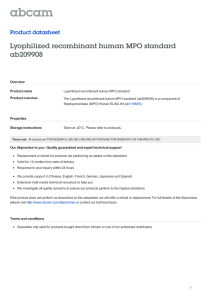
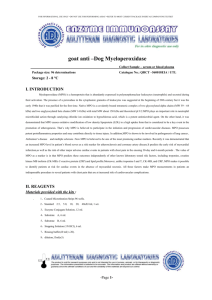
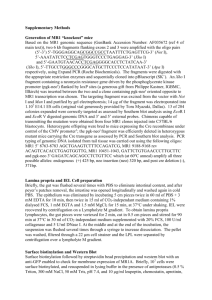

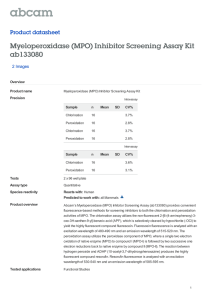

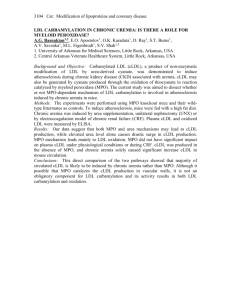
![Anti-Myeloperoxidase antibody [2A11] (HRP) ab24467 Product datasheet Overview Product name](http://s2.studylib.net/store/data/013130054_1-cad7275505c73a79080c64ab4a051027-300x300.png)
